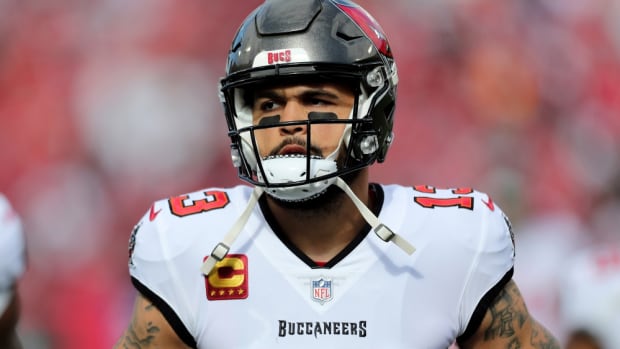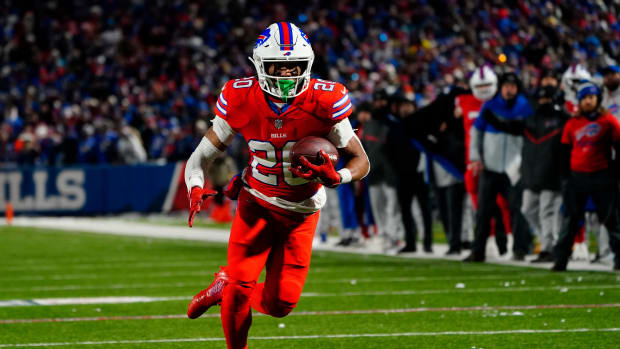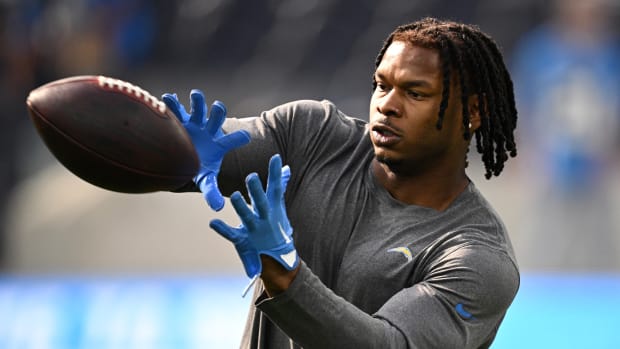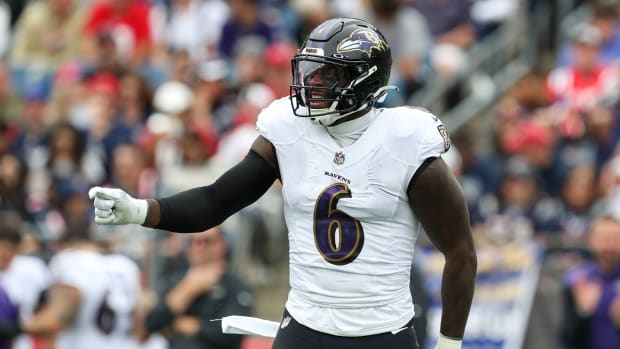2013: Year of the Injury?
Dustin Keller went down with a serious preseason knee injury just a few months after signing a one-year deal with the Dolphins. (Scott Halleran/Getty Images)
Three weeks ago, in the visitors’ locker room at MetLife Stadium, was a team overwhelmed by injuries.
The Packers had just lost their third straight game, to the Giants, and even their most veteran players couldn’t recall the last time that had happened (it was 2008). Their winless streak, of course, has by this point extended to five games. And, despite the team’s "next man up" and "no excuses" mantras, yet another growing injury tally—14 players on a reserve list because of injury, not to mention a starting quarterback sidelined with a broken collarbone—was feeling untenable.
"Ultimately, starters are starters for a reason," linebacker Clay Matthews said that day, on which he’d ditched the bulky club worn to protect the broken thumb that sidelined him for four games. "They’re great players who play exceptionally well, and it’s no different on this team."
The toll of injuries is simply part of the NFL, but has that toll been greater in 2013? Anecdotally at least, it’s seemed like that’s been the case, from four of the Patriots’ lynchpin starters going on injured reserve (Vince Wilfork, Jerod Mayo, Sebastian Vollmer and Tommy Kelly), to five separate teams each losing at least four players to ACL injuries (Eagles, Jets, Panthers, Saints and Steelers).
The MMQB examined a couple metrics of the injury incidence this season compared to years past: The number of players unavailable to their teams in the first week of December because of an injury sustained in the NFL (players on injured reserve, PUP-reserve or practice squad-injured reserve were counted, but not those on the non-football injury list), and the number of players who suffered an ACL injury. The indications from our small-scale, and albeit limited, analysis: Injuries continue to follow an upward trend, though there has not been a dramatic uptick in 2013.
The number of players on reserve lists with injuries is not a medical statistic, since other factors like strategy play a role in roster management, but it can give a snapshot of how teams are being affected by long-term injuries. We counted 269 injured players currently on NFL reserve lists this season, compared to the same week in 2012 (264), 2011 (252), 2010 (253) and 2009 (223). (We used archived rosters on Ourlads.com for the first week of December the past four seasons; for 2013 we counted only players currently on reserve lists, since players waived from IR can return to play for another team later in the season).
Based on this count, the Packers (14), Redskins (13), Colts (12), Jets (12), Panthers (12) and Steelers (12) are the teams currently with the most injured players on reserve lists.
| 2009 (12/1) | 2010 (12/1) | 2011 (12/1) | 2012 (12/1) | 2013 | Team Total |
3 | 5 | 6 | 10 | 10 | 34 | |
8 | 4 | 5 | 8 | 9 | 34 | |
12 | 6 | 6 | 11 | 5 | 40 | |
15 | 8 | 14 | 8 | 6 | 51 | |
8 | 12 | 12 | 11 | 12 | 55 | |
7 | 3 | 7 | 4 | 5 | 26 | |
6 | 11 | 4 | 10 | 11 | 42 | |
8 | 10 | 6 | 9 | 9 | 42 | |
3 | 3 | 3 | 11 | 8 | 28 | |
3 | 5 | 8 | 9 | 8 | 33 | |
13 | 12 | 10 | 8 | 5 | 48 | |
8 | 13 | 4 | 10 | 14 | 49 | |
10 | 9 | 11 | 8 | 11 | 49 | |
7 | 12 | 11 | 11 | 12 | 53 | |
8 | 14 | 18 | 16 | 6 | 62 | |
7 | 6 | 8 | 9 | 6 | 36 | |
7 | 10 | 4 | 2 | 4 | 27 | |
0 | 3 | 7 | 4 | 4 | 18 | |
6 | 11 | 10 | 11 | 11 | 49 | |
12 | 8 | 6 | 8 | 9 | 43 | |
6 | 11 | 12 | 10 | 10 | 49 | |
3 | 3 | 7 | 7 | 12 | 32 | |
Oakland Raiders | 4 | 2 | 6 | 7 | 5 | 24 |
6 | 7 | 3 | 4 | 5 | 25 | |
4 | 5 | 7 | 5 | 12 | 33 | |
San Diego Chargers | 7 | 8 | 10 | 5 | 9 | 39 |
4 | 6 | 5 | 4 | 7 | 26 | |
4 | 9 | 12 | 4 | 8 | 37 | |
St. Louis Rams | 9 | 11 | 13 | 3 | 6 | 42 |
12 | 8 | 7 | 11 | 12 | 50 | |
4 | 9 | 3 | 13 | 5 | 34 | |
Washington Redskins | 9 | 9 | 7 | 13 | 13 | 51 |
Yearly Totals | 223 | 253 | 252 | 264 | 269 |
|
Matt Matava, Rams team physician and president of the NFL Physicians Society, says he does not yet see a "worrisome" trend in injuries—but adds that this year’s tally may appear notable given the number of injuries that happened early in the season and the number of big-name players who have had their seasons end. Indeed, 10 quarterbacks are currently on injured reserve; just two quarterbacks were on IR at this point in the 2012 season, and eight in 2011. Also, seven of last season’s elected Pro Bowlers (not including alternates) are on season-ending IR heading into Week 14, compared to four of the previous year’s Pro Bowlers in both 2011 and 2012.
We also looked at the number of ACL injuries this season, since the preseason seemed to bring a rash of them, most notably when four Eagles players were lost to serious knee injuries in a span of three weeks. We acquired the NFL’s ACL injury data from 2004-12 through Edgeworth Economics, an economics and statistics consulting firm that works with the players’ union to analyze injury trends. For 2013, we produced our own unofficial tally of the number of ACL injuries based on team releases, media reports and our own reporting.
We counted 27 preseason ACL injuries, the highest tally since records were first kept in 2004. Past preseason counts ranged from 12 (2005, 2006) to 25 (2008), though preseason rosters were also increased from 80 to 90 players in April 2012, putting an additional 320 players in camps.
What about the rest of the season? Though 13 weeks of the regular season, there have been 23 ACL injuries, for a total of 50 so far in 2013. In the past five seasons, the total number of ACL injuries has ranged from 48 (2011) to 56 (2009, 2012), including four additional weeks of the regular season and four weeks of the postseason. If the 2013 regular-season rate of ACL injuries continues, the total would be at about 57 before the playoffs begin; the last three postseasons have resulted in between one and four ACL injuries. Only the final numbers will tell the full story, but the 2013 season could yield the greatest number of ACL injuries in an NFL season on record, even if not the dramatic surge it may have seemed like.
Says Steelers assistant team physician Robin West, "I think the rate is higher, and the question is, why is it higher? It's certainly higher in the preseason, and that's because there are more guys on the team, people are trying to make the team. That's one of the things, but why is it higher overall?"
One severe knee injury in particular—the ACL, MCL and PCL tears plus knee dislocation sustained by Dolphins tight end Dustin Keller on a low hit by Texans safety D.J. Swearinger in the preseason—sparked discussion on if the league’s emphasis on policing helmet-to-helmet hits would result in players’ knees being targeted. Of the 50 ACL injuries suffered this season, we were able to find clear video footage or detailed descriptions of how the injury happened for 32 of them, and Keller’s was the only ACL injury in that sample size that occurred because a defender went low on his opponent to make a tackle.
'It Feels Horrible'
Players are still struggling to accept the league's rationale for a full season of Thursday night games. Can the NFL reasonably claim that it cares about player safety when it forces every team to play on a short week? FULL STORY
We recorded eight of these 32 ACL injuries resulting from contact: Besides Keller’s, examples included a knee crashed into at the line of scrimmage, or one offensive lineman accidentally cut-blocking his own teammate, as happened with Pittsburgh’s David DeCastro and Maurkice Pouncey. The other 24 ACL injuries we classified as non-contact injuries. West says that studies show about 70 percent of ACL tears result from non-contact injuries; our unofficial sample, showing 75 percent non-contact injuries, is on par with that figure.
The NFL internally monitors injury trends. Team injury information is reported to the league office by athletic trainers and team physicians, and an outsourced company compiles and analyzes the data in the NFL’s official "Injury Surveillance System." Reports are created after the preseason, every four weeks during the regular season, and following the playoffs, Matava said, and are distributed to each of the league’s safety committees. The data is used to inform rule changes, or check the effectiveness of rule changes for safety—the most notable example being the decrease in head injuries suffered on kickoffs after the starting line was moved up.
The new collective bargaining agreement agreed to in 2011 dramatically changed the landscape of how teams practice, reducing the length of the offseason program, eliminating two-a-days and cutting down the number of padded practices. The goal was to promote player safety, but West said she's curious to see if, over time, more time off is shown to play a role in increased rates of some injuries. It's premature to say there has been an impact on safety either way, but one theory West mentions is that players may be less supervised or less conditioned with more time away from the facility, and have less access to things like ACL prevention programs that use specific exercises to strengthen muscles in the core and around the knee.
The NFL’s injury surveillance data, courtesy of Edgeworth Economics, shows a slow upward trend in the total number of injuries sustained in all practices and games from 2004 (2,623) to 2012 (3,126); a spike of 4,493 injuries in 2011 was attributed mainly to greater reporting of minor injuries that season. The data also shows a steady annual increase in the number of injuries that require surgery and those that result in eight or more days of missed playing time.
At this time of year, we’re reminded that some teams, like the Packers, seem perennially snakebitten by injuries. "We face this every year," cornerback Tramon Williams said. "We’ve always played through it." Yes, they famously won the Super Bowl in 2010 with 15 players on injured reserve, but where is the breaking point? Aside from facts and figures, the next few weeks will highlight the other way to measure the toll of injuries—the impact they have on a team’s season.
Emily Kaplan contributed to this story.






































